To be able to remember is one of the fundamental conditions of being human.
Imagine us living from moment to moment, not remembering what happened a moment ago, as most animals do; life would be utterly without meaning. Memories not only bestow humanity with a sense of meaning but also give us a sense of time; past, present and future. We would have no use of the concept of time had it not been for the fact that we remember at least a part of the past. But not all the past is worth remembering. There is an unconscious filtering process in the mind that assigns some events of the past more significance than others. These choices we make give us a sense of who we are.
Thus, accessing the past is essential, especially the distant past, the events which we did not take part in or personally experienced. We do so through traces of those events left by our ancestors on the sands of time. These traces take varied forms such as cave paintings, myths, parables, fables, folktales, epic literature, art, festivals, traditions, and in more recent times, historical chronicles. However, all these forms are representations in the sense that those ancient memories have, over the centuries, been so internalised into our civilisational bloodstream that when they reappear they are stripped of their specificities of time and place and are presented as parables or fables, as succinct, didactic stories, in prose, verse or art, that illustrate one or more instructive lessons or principles buried under those specificities. What they illustrate now is addressed to the entire humanity and for all ages. Homer’s Iliad and Odyssey, sage Ved Vyasa’s Mahabharata and Valmiki’s Ramayana are such epic stories through which we access our ancient past. The specificity of where and when they happened or the historical accuracy of the events is not relevant. Over the centuries, their tellings and re-tellings, with modifications and additions, have given them a robust presence in our consciousness.
Moreover, before the invention of paper as the mode of cultivating and transferring knowledge in written form, this was done through an elaborate oral process of memorising. With the social segregation that set in within Indian society more than 2000 years ago, access to such memorisation was restricted by the social status of the person. As a result, in pre-colonial times, two broad streams of memory-based knowledge spectrums continued to co-exist: One, the spectrum of the smriti (memory) tradition of those who had access to abstract symbols, such as the Sanskrit language, including writing. We call this the classical knowledge stream. With the availability of writing, this knowledge was preserved in Sanskrit texts.
And two, the spectrum of the same smriti tradition but of those who were prevented from learning Sanskrit due to their low status in the social hierarchy. However, the remembered paramparas were ‘preserved’ through transmission from generation to generation through the multiple local oral dialects (boli, that which is spoken), which only much later evolved as matured languages, the Bhashas. We refer to this as the Bhasha knowledge stream.
But the crucial point to note is that, with the decline of Sanskrit, the classical knowledge stream ended up confined to academic libraries without any opportunity to assimilate new ideas and grow. The Bhasha stream of knowledge, on the other hand, though without access to the written form of preservation, faced a formidable hindrance to producing any genuinely universal knowledge, but fortunately, was able to assimilate new ideas through communication with external sources and grow.
While the classical stream has preserved the knowledge in written form but failed to grow, the Bhasha stream grew as robust knowledge by preserving memories in multiple languages but failed to keep systematic records. It is available only in stories, songs, folktales and folk architecture.
Thus, the two knowledge traditions, one with oral and written presentations and the other with only the oral form, remained cut off from each other, like two banks of a river, without any possibility of ever meeting and cross-fertilisation. Moreover, the split between the social section that had easy access to letters, the elites, and that which was denied this access aggravated the crucial transition from medieval times to modernity. It made it difficult for India to bring together, in a grand single historical narrative, all knowledge—all memories—as the universal identity of the people of this land.
But history is not the only way to access the past. History as a knowledge stream, as we know it today, is relatively new and much alien to the Indian consciousness of the past. The word for ‘history’ in Indian languages, especially those derived from Sanskrit, is ‘itihasa’. But the meanings of the two words are radically different. Etimology of itihasa is iti-ha-asa, ‘that is how it has been’.
Its first reference is found in Kautilya’s Arthsastra (321-296 BCE). Kautilya tells us what constitutes itihasa: “Purana, itivritta (annals), Akhyayika (tales), udaharana (examples), dharmasastra and arthasastra are (known by the name) itihasa.”1 Puranas are mythical stories; Itivritta denotes records of occurrence or event; the akhyayika is a prose composition, a narrative; and the dharmasastra and arthasastra denote the two classes of literature dealing with morals and material well-being, respectively. Udaharana comes closest to the conventional reading of history as teaching by example. Indian civilisation is far more comfortable accessing the past through customary practices, folklore, epic literature and Puranas. Conveying moral and ethical values through allegorical tales is more critical than rational historical information of origins, provenance and progression.
There was one aspect of culture that facilitated this—traditions. Keeping the past alive as part of the present are the traditions, which are the backbone of all cultures; Traditions are the creation and preservation of significance and transcend and bridge the social divide. This also means that the temporal dimension, a sense of past, present, and future, is always assumed to be an underlying factor. ‘Tradition’ translates in Indian languages, mainly Sanskrit and Sanskrit-based regional languages, as parampara. Paramparas are the memories of the past that have been kept alive for their significance in the present. Paramparas tell us, ‘That is how it has been’.
Paramparas, then, are also a form of itihasa—a way to access the past. The moral and ethical lessons from past occurrences, when generalised and divorced from their specific provenance, become paramparas.
In the previous two segments of this series, I have elaborated on the symbolic nature of spiritual architecture, both Hindu and Islamic, through historical analysis. In the first essay, we have examined the theoretical underpinning of spiritual architecture. Here, I want to focus on temporal architecture, wherein itihasa and parampara play a far more critical role. Indian thought world, even if we limit our gaze to Hinduism only, is open-ended. There are not one but six different schools of thought that constitute Indian philosophical parampara. Each is called darśana (viewpoint or perspective, from the Sanskrit root drish, meaning to see or experience looking at, viewing, beholding). These darśanas are Samkhya, Yoga, Nyaya, Vaisheshika, Mimamsa, and Vedanta. Each accepts the Vedas as an authority but differs in their interpretation. Today, we find this counterintuitive; we are more comfortable with a singular philosophical explanation of reality. In other words, a theory must be singular and applicable in all conditions. Ancient sages, rejecting such a syncretic singularity, decided to let these multiple schools prevail, even when they radically differ from each other. Thus, not a singular overarching Hindu philosophy but several parallel thought streams characterise the Indian thought world. Of these, Samkhya (rationalism, strongly dualistic), Nyaya (logic, sources of knowledge), and Vedanta (strongly non-dualistic, ideological, mythical) are the dominant ones.
Interestingly, similar divergence of views of reality can be found briefly in Europe, too, during Rennaisance. The young architect/painter Raphael’s famous painting of 1511, The School of Athens, shows the central figures of Plato and Aristotle seemingly engaged in a debate. The idealist Plato is shown with a finger pointing upward indicating his preference for spirituality, while the more pragmatic Aristotle points his hand downwards advocating a more earthly and temporal approach. However, by the time Raphael painted this, the Kantian/Cartesian approach had completely occupied the European mind which cherishes uniformity, codified laws, and certitudes. This painting, by the way, is a fine example of the embodiment of memories. It depicts several ages of secular knowledge with portraits of philosophers, artists and mathematicians of the past. It even has, in the lower left corner, the Arab scholar Ibn Rusd (Averroës).
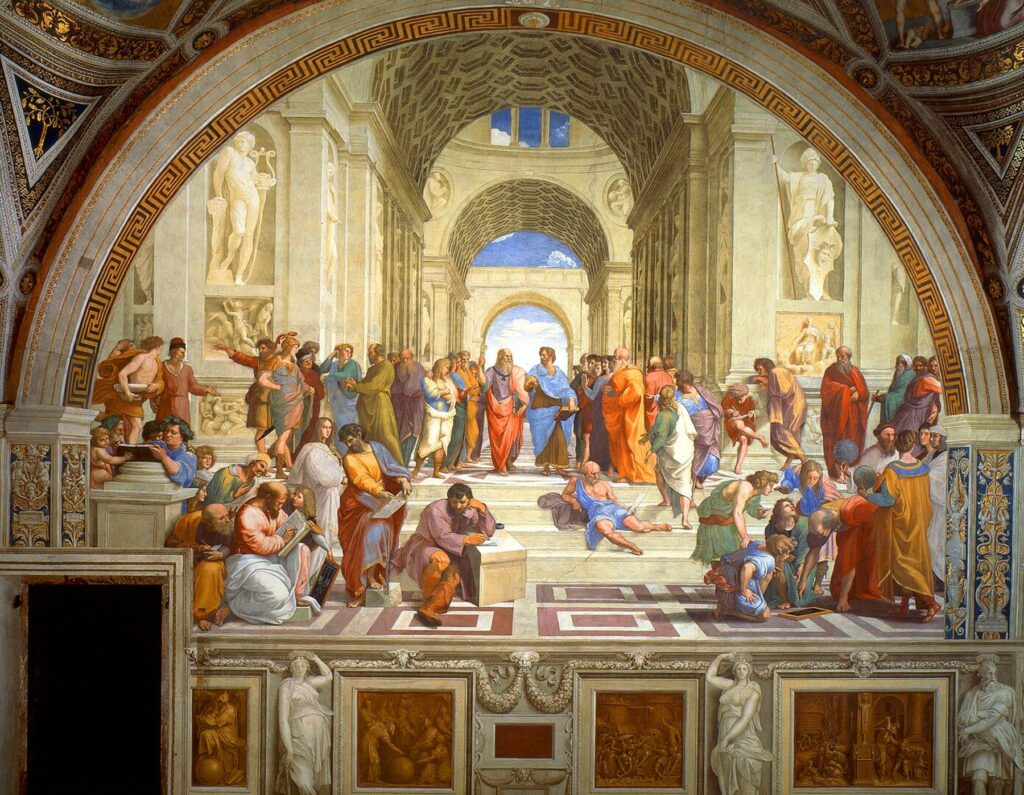
Seen in this larger context, we realise that the ideas that animate the spiritual temple architecture, the Vastu-Purusha mandala, are Vedantic. Vaastu-Purusha represents the non-duality (Advaita) of consciousness and matter. This non-duality underlies mythical consciousness, which explains its most distinctive feature: its total disregard for the distinction between consciousness and matter. This unity of the abstract and the concrete is particularly suitable for symbolically representing the cosmic reality, the greatness of the universal and the eternal, in the form of the temple.
On the other hand, Samkhya’s dualism views reality as composed of two independent principles, Puruṣha (consciousness or spirit, beyond perception), and Prakṛti (the phenomenal world of experiences and perception). The purusha is ubiquitous, all-conscious, all-pervasive, motionless, unchangeable, immaterial, and without desire. Prakrti is the universal and subtle nature that is determined only by time and space. It is the phenomenal nature all around us and of which we as a species are an integral part. Purusha, the cosmic spirit, exists beyond the realm of time and space and observes Prakrti, the material world, which evolves in response to Purusha.
Samkhya is also known as the rationalist school of Indian philosophy. In Samkhya-Yoga texts, Prakrti is the potency that brings about evolution, causality and change in the empirical universe. Being a part of the empirical universe, Prakrti is also a repository of history/itihasa. It is also the realm in which temporal architecture operates. We can access not only the past, subject to evolution and change but also the unchanging truth of architecture. Indian temporal architecture, then, must be seen from a different perspective than the spiritual temple/ architecture. If the spiritual architecture of temples represents the Vedantic tradition of non-duality (Advaita) of consciousness and matter, temporal architecture represents the duality of the abstract consciousness of the ‘spirit of architecture’ on one hand and the concrete and material built form in the phenomenal world of Prakṛti (nature) on the other.
Architecture is a threshold between humankind on the one hand and the natural world of our experiences of space and time, here and now, on the other. What if we view Indian temporal architecture as a representation of this dualism, Puruṣha and Prakṛti? Would it not reveal a different relationship between us, humans, and nature? What role does architecture play in actualising this relationship?
On a more immediate level, we may ask, is there anything common between all these disparate temporal architectural forms we have built so far? What is the constant deep structure—the spirit of architecture—if these buildings are varied due to historical, cultural and geographical reasons? This ‘constant’ will have to be present in the architecture of all religions, all communities, all regions, and all eras. Such a theoretical inquiry must answer to both classical and vernacular knowledge systems. Would it not provide a basis for a coherent theoretical proposition, a universal principle? Could we not have one explanation for the spiritual architecture of temples, mosques and other places of worship and another for the secular, temporal architecture for all the places of human accommodations?
I have been confronting our history with just such questions for the last several years and have come up with interesting answers. Such an interrogation of history reveals that the constant we seek for temporal architecture is not in the formal and aesthetic qualities but in the non-material relationship with which various elements of architecture are brought together. In other words, in the way architecture is conceived. While the formal expressions change from region to region and from time to time, the idea remains constant: architecture is the abode of human consciousness and an expression of man’s relationship with prakriti or, in an earthlier way, with nature, the external environment. The way architecture negotiates this relationship with the environment and the elements that such negotiations have evolved distinguish architecture in the Indian sub-continent from that of the rest of the world. It is apparent in various forms and for an equal variety of occupations.
Temporal architecture, except for large palaces and forts, has not survived as ordinary peoples’s houses were not built with durable materials. However, what survives are their memories. These memories are carried forward through what I call architectural folklore and legends. Unlike the literary folklore we are familiar with, these are buildings; either marginalised as vernacular architecture or romanticised as ‘architecture without architects’. These are the Nalukettus of Kerala, Hawelis of Gujarat and Rajasthan, the Chettinad houses of Tamil Nadu, the Kath-Kunis of Himachal Pradesh and the Badal Houses in the deserts of Rajasthan.
Their formal resolutions may vary in response to their local specificities, But, stripped of these, they all refer to the memories of centuries of dwelling on this earth. These are not the memories of materials, craft and technologies or the utilitarian aspects of dwelling; they are of the poetics of architecture.
A house in India is a threshold between the finite world of man and the infinite world of nature. A threshold ensures that the relationship between the two is never adversarial. It is a human intention expressed in architectural and poetic terms. Through the design of a house, a man relates the collective memories of the past to the individuality of his own life. Thus, a true house not only locates itself in the larger history of human settlement but also becomes unique, meaningful and incapable of being reproduced.
A typical traditional Indian house embodies ideas and values about life, humans, nature, and the relationship between all three. It sees a house not as a closed enclosure and as protection from a supposedly hostile nature or the external world. Nature is not hostile but a nurturing being in whose bosom humans can realise their true selves by finding connections with other beings. Its deep structure can be diagrammatically represented by three concentric circles representing the threshold. It represents the relationship between humans and nature that exists in the architecture of the humblest hut and the grandest palaces. It is actualised in classical and vernacular architecture. Stripped of regional variations, family specificity, size, and technology, all belonging to the here and now, we uncover a timeless truth, the constant deep structure, that has come to us through tradition and conventional practices, like architectural folklore, a legend. I name this ever-lasting truth Trikosha Pratihara (three-layered threshold).
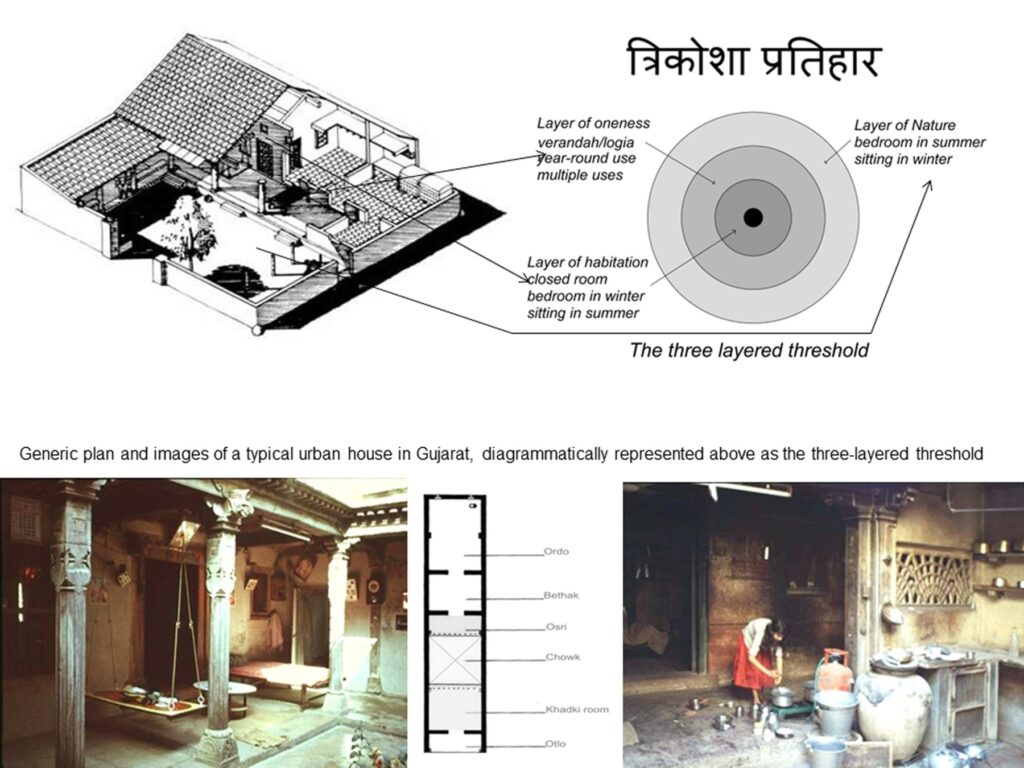
There are regional variations of the same legend, which has survived not in classical architectural literature in Sanskrit, but in many regional languages (bhashas) and conventional ways of making architecture. It may be subject to historical evolution, but it belongs to itihasa—iti-ha-asa—that is how it has [always] been. The house, or, for that matter, any building, thus, is a dynamic environment changing according to the cycle of seasons or day and night. The spaces acquire their meaning not by labels such as living room, bedroom, or kitchen; the meanings are contingent and contextual. Ambiguity is preferred over certitude. The binaries of public/private or inside/outside are blurred. The order is entirely experiential. The generic plan form represents the rational logic of the house independent of its corporeal form. Most artisans in their region have internalised this.
This vernacular template of the three-layered threshold is not limited to residential architecture alone, nor is it limited to any region; in different forms, it has been present throughout history and all over India. Variations and improvisations did occur, but its core form remains true to this unspoken ‘agreement,’ a consensus that arrived long ago. This generic form remained constant even when the house’s scale and context changed. One finds similar elements in similar configurations in simpler, smaller, family houses and larger, more luxurious, stately mansions in rural and urban contexts.
The above brief overview makes it apparent that at both the spiritual and temporal levels, ‘theory’ has a robust presence in Indian architecture. It is not in discursive form (language) but in visual form—the mandala of the universe and the temporal threshold. As Susanne langer has said eloquently,
“All thinking begins with seeing; not necessarily through the eye, but with some basic formulations of sense perception, in the peculiar idiom of sight, hearing, or touch, normally of all the senses together. For all thinking is conceptual, and conception begins with the comprehension of Gestalt.”2
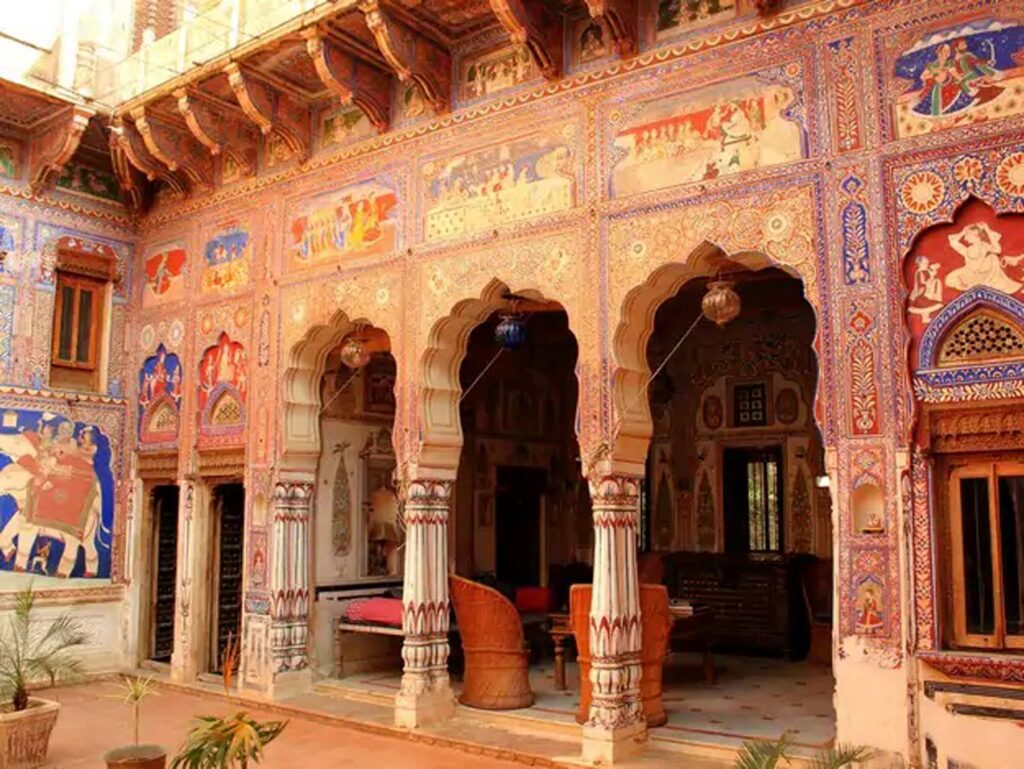
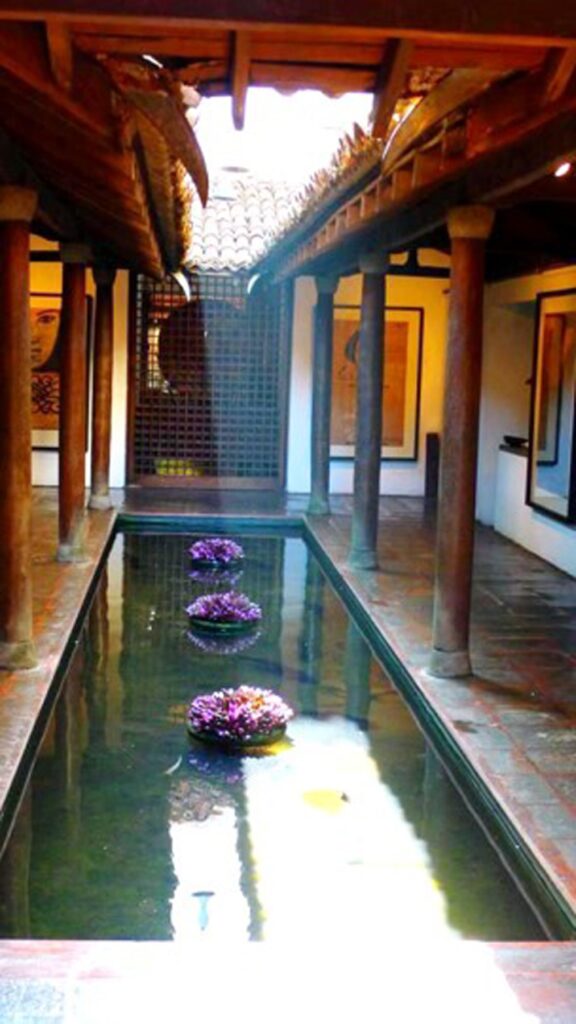
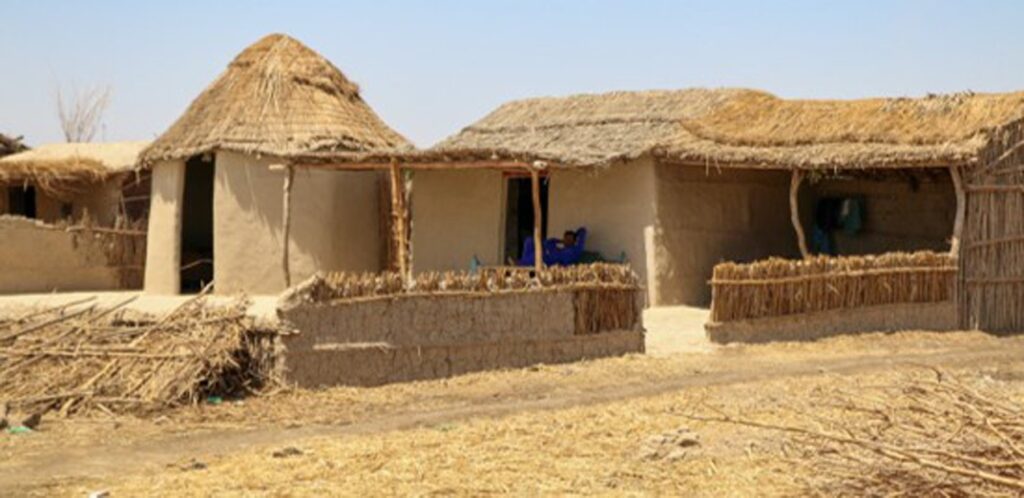
It must be noted that the template ‘three-layered threshold’ is more like an earthly practice than a ‘theory’ in an academic sense and has remained and survived as memories of lived experiences. We find it expressed in countless buildings of all types, including some temples since the 12th century, and in all parts of the subcontinent. Transcending all regional, religious, climatic, and subcultural diversities, this is one aspect of Indian architecture that has weathered evolution and cultural and technological changes. The reason for its survival is that it is spatial and not formal. Space reflects a people’s deep-rooted attitude to placemaking and is part of a civilisation’s core values. It is the eternal and immutable half of the art of architecture, the other half being the formal language, the ephemeral, the fugitive and the contingent, susceptible to change, to paraphrase Charles Baudelaire.
Why is it that this earthly practice of the three-layered threshold has never been articulated, mentioned or discussed in any of the learned traditions, which we now hold as the fountainhead of all wisdom and authority in matters of architecture until now?
The fact that it has not been formulated as a theory in the textual form is for an excellent reason. Formalised knowledge requires two things: patronage of power and a medium of expression (language). Both the theistic theories of the Mandala and the Garden of Paradise had these elements in their favour. Both Hindu and Islamic rulers saw sponsoring the building of temples, mosques, maqbaras and dargahs as an essential aspect of their governance. Piety and generosity towards religious institutions have always been a marker of a ruler’s virtue. Patronage, thus, was never a problem for religious architecture. The rulers generally did not distinguish between Hindu and Muslim communities in the matter of sponsoring religious architecture.
At the same time, the ideas that informed the architecture of these buildings, the classical stream of knowledge, were well formulated in Sanskrit (Hindu) and Persian (Islamic) languages. Two of the oldest and most sophisticated languages, the status, function, and place of Sanskrit and Persian/Urdu in India’s cultural heritage are beyond contest. However, neither was ever the language of the commoner. They were never the language of the bazaars; their use was limited to the upper-class elites and the ruling class. The classical knowledge contained in these two languages was not available to ordinary people. The non-availability of this knowledge and the inability to interpret it placed the general population dependent upon the regional dialects. They built their houses and other places of accommodation through knowledge contained in their local dialects. These were good enough to conduct day-to-day communication but not developed enough for expressive cultural constructs like literature, poetry or theoretical formulations.
In other words, as formal education of classical knowledge belonged to the few elites, the knowledge of earthly practices and experiences of life’s complexities, expressed in art, architecture, music, and dance, were perceived and articulated through the local dialects and preserved in civilisational memories. These dialects began to acquire the status of Bhashas (regional languages) only after the 12th century.3 This phenomenon has left a gap between the lived experience and formalised knowledge. This is at the root of the non-formalisation of the ‘three-layered threshold’ as a theory and its transition to modernity in an organic way.
Thus, European scholars and historians, unacquainted with the bhasha culture, were in the dark about the multiplicity and diversity of the thought worlds that lay concealed in this indigenous culture.
Ancient Indic and Islamic worldviews were mythical and saw the world as a whole, a singularity, an implicate order, wherein everything is enfolding (not unfolding) upon itself. However, this did not coincide with the then-current architectural discourse founded on the dominant Kantian/Cartesian view of the world, and the Hegelian historiography. The Enlightenment cherishes uniformity, codified laws, and certitudes in means of
communications and operations. On the other hand, India is a civilisation that avoids finality, prefers the unfinished, is ambivalent, and cherishes the contingent and the contextual, as the anthropologist Walter Goldschmidt says.
“Anthropology has taught us that the world is differently defined in different places. It is not only that people have different gods and expect different post-mortem fates. It is, rather, that the world of different peoples has different shapes. The very metaphysical suppositions differ. Space does not conform to Euclidean geometry; time does not form a continuous unidirectional flow. Causation does not conform to Aristotelian logic. Man is not differentiated from non-man or life from death, as in our world.”4
The glaring infirmity of the Vistara exhibition (part 2 of this series) and its adoption of the mandala as the underlying deep structure for all architecture, “ Architecture as the model of the cosmos”, is that it was never able to explain the contemporary architecture, practised today, in all its diverse forms through the template of the mandala. I believe, it was because Team Vistara failed to recognise that two parallel knowledge streams animate Indian architecture; the classical Sanskrit/English stream and the vernacular oral stream.

One is more aligned with global modernity, the other is rooted in the Indian vernacular traditions. This is understandable as it is counter-intuitive to have two theories for a single phenomenon. In modern science, the term ‘theory’ refers to a well-confirmed explanation of nature, made in a way consistent with the scientific method, and fulfilling the criteria required by modern science. Theories are described in such a way that scientific tests should be able to provide empirical support for them or empirical contradiction (falsification) of them.
However, architecture is not science. Science is dedicated to the pursuit of knowledge. In architecture knowledge and action are intertwined, feeding on each other: action engenders knowledge, and knowledge, in turn, gives rise to new actions, and new ways of doing architecture.
If theory implies a belief that engenders action, then theory in architecture is always going to be relative to the cultural ethos. The cultural condition of modern India has a dilemma at its roots; how to preserve the memories of the past while embracing global modernity, and,
at the same time, how to fulfil the desire to be modern while remaining rooted in the traditions that are still alive.
This dilemma was never resolved. Reminiscent of the famous 8th-century philosophical debate between Adi Shankaracharya, the ascetic, and Mandana Mishra, the householder, memories of which are etched in the collective Indian psyche, the poet, polymath and cosmopolitan man, Rabindranath Tagore and the father of the nation Mahatma Gandhi conducted a public debate through newspapers and journal articles about the direction the new nation may take. And not unlike the ancient debates, neither prevailed.
This explains the complex ways in which contemporary architecture in India has confronted modernity. Two contrasting approaches are discernable in the initial years immediately after independence. Both recognise the value of the simultaneous existence of the memories of the whole world (global modernity) and the memories embodied in architectural folklores (Indian vernacular). But they differ in the way this simultaneity is to be actualised in architecture. One approach prioritises global modernity, moderated by subjecting it to the traditional ways. I call this the ‘Way of Tagore’. Tagore advised India to welcome the winds of change that have been shaping global humanity while remaining conscious of traditions. Gandhi’s approach was to build a uniquely Indian modernity from the ground up. It seeks to modernise the traditions rooted in the bhasha culture by finding new forms that resonate with our aspirations to be modern. I have named it the ‘Way of Gandhi. I have analysed the works of a few selected (purely arbitrarily and based on my access to their works) architects to demonstrate these two streams.
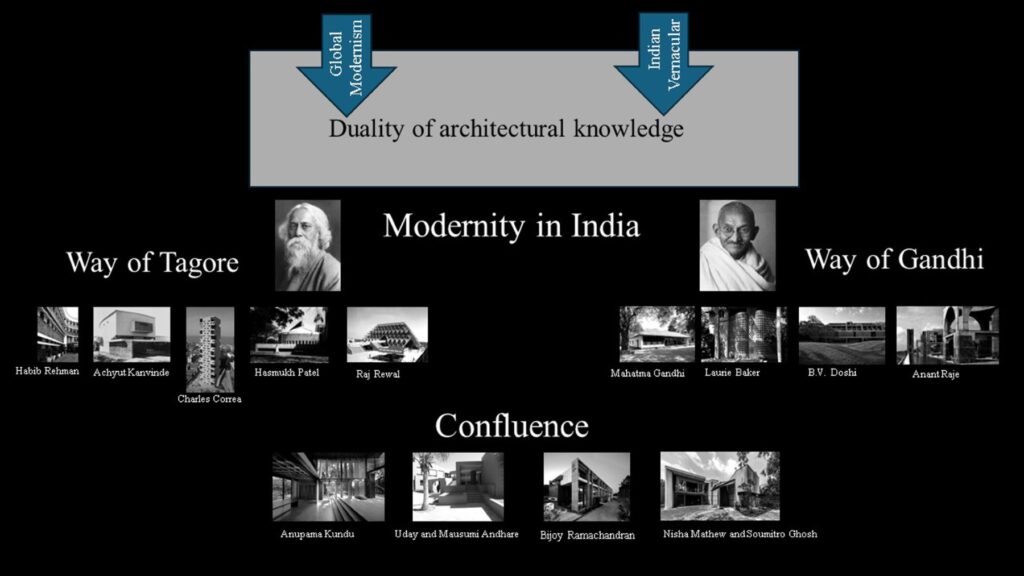
Green shoots of a third approach have been visible in the works of some young architects since the turn of the century. The ways of Tagore and Gandhi seem to come together like the confluence of two streams into a mighty river. More exposure to global architecture and its history, and having been trained in European or American universities, has made these young architects more relaxed about the relationship between Indian itihasa and global history. They have overcome Eurocentricity and view global history as made up of several civilisational memories; India being a part of this phenomenon. Hegel’s and Bannister Fletchure’s historiography is irrelevant. The repertoire of memories they bring to substantiate their architecture encompasses not only the 15th-century
Hazara Rama temple at Hampi, the 19th-century Shiva temple at Hetampur but also the 16th-century, The School of Athens, by Raphael and the 20th-century Guernica of Picasso.
- Kautalya, Arthsastra, trans. R. Shamasastry, Mysore Printing and Publishing House, Mysore. 1967. P.6. ↩︎
- Susanne langer: Philosophy in a new key: A Study in the Symbolism of Reason, Rite, and Art, A mentor book, Published by the New American Library. P. 216. ↩︎
- G.N. Devy, The Bhakti Movement: Pre-Colonial Social Transition, in The Indians: Histories of a Civilization, Aleph Book Company, New Delhi, 2023. pp. 373-379 ↩︎
- Walter Goldschmidt, ‘Foreword’ in The Teachings of Don Juan: A Yaqui Way of Knowledge, by Carlos Castaneda, University of California Press, Berkeley, 1998. P. 10 ↩︎
Note:
This is the third of a three-part series of preview essays for Jaimini Mehta’s forthcoming book, Sense of Itihasa; Architecture and History in Modern India. The book is in two parts;
- Theoria, exploring the representation of Indian architecture in colonial historiography, and
- Praxis, analysing the work of several contemporary, post-independence, architects from the perspective and insights so gained in the first part.
These three essays include excerpts from the first part. The book, published by CEPT University Press, is expected to be available by the end of 2024 or early 2025.






